May’s decline marks the largest drop in six months and is greatly attributed to a decrease in orders for aircraft. While previously a strength, aircraft orders have declined for the second time in two months with a 12 percent decrease in orders for commercial aircraft and a 31 percent decrease in orders for defense aircraft, a notoriously volatile category.
Core capital goods were another area of weakness in May with an unexpected 0.2 decline in both orders and shipments for this category.
In contrast, there was a 0.6 percent increase in machine orders, a 1.2 percent increase in vehicle orders, and a 0.8 percent gain in total shipments.
Excluding the category of transportation (which does not include aircraft), durable goods orders also rose very slightly, increasing by 0.1 percent/
While not completely negative, May’s readings point to a lack of confidence in business prospects in the United States.









